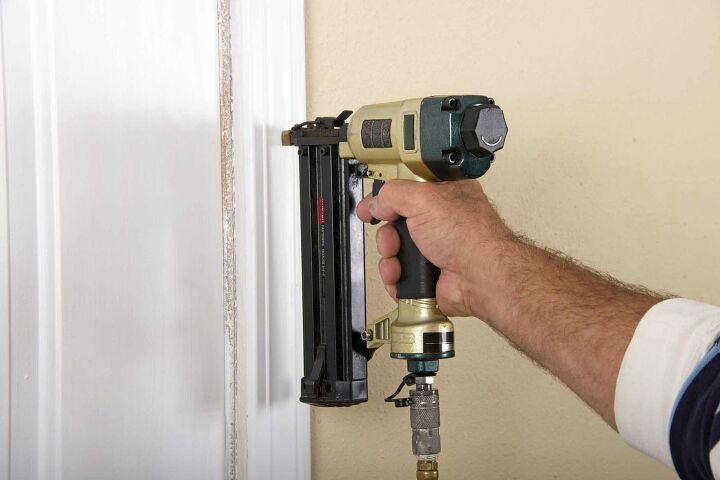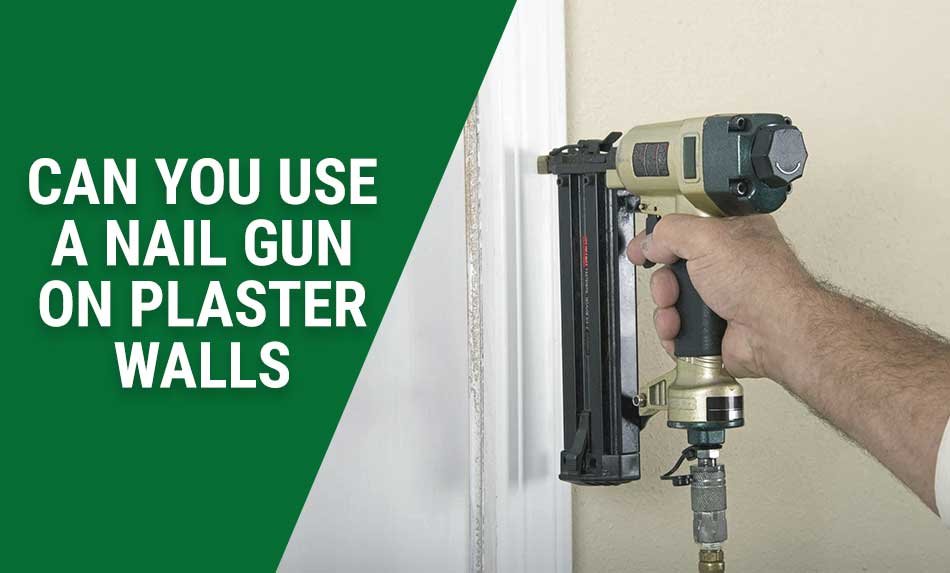Imagine you’re renovating your room and you’re excited to hang up some new artwork or shelves on the walls. But then you realize that your walls are made of plaster, and you start to wonder: can you use a nail gun on plaster walls? Well, you’ve come to the right place to find out!
Using a nail gun can certainly make your job easier and more efficient, but it’s important to know whether it’s suitable for plaster walls. In this article, we’ll explore whether using a nail gun on plaster walls is a good idea, and if so, what precautions you should take. So let’s dive in and discover the world of nail guns and plaster walls!
Plaster walls have been around for centuries and are known for their durability. But when it comes to using a nail gun on them, it’s not a straightforward yes or no answer. There are factors to consider, such as the age and condition of your plaster, that can affect the outcome. Don’t worry, we’ll unravel the mysteries and guide you through the process, so you can confidently tackle your wall-hanging projects with ease. Let’s get started!
Using a nail gun on plaster walls can be tricky. While it is possible to use a nail gun, there are a few things you need to consider. First, make sure you have the right type of nails that won’t damage the plaster. Second, adjust the nail gun’s depth setting to prevent over-penetration. Finally, handle the nail gun with care to avoid cracking or chipping the plaster. Remember to always test on a small, inconspicuous area before proceeding.

Can You Use a Nail Gun on Plaster Walls?
If you’re looking to hang a picture or install some shelves on your plaster walls, you may be wondering if it’s safe to use a nail gun. Plaster walls can be delicate, and you don’t want to risk damaging them. In this article, we will explore whether it’s possible to use a nail gun on plaster walls and provide you with some tips and precautions to keep in mind.
Understanding Plaster Walls
Before we delve into whether it’s safe to use a nail gun on plaster walls, it’s important to understand what plaster walls are made of. Plaster walls are a traditional form of wall construction that predates drywall. They are made by applying several layers of plaster over a lath structure, which consists of narrow strips of wood or metal.
Plaster walls can be fragile compared to modern drywall, and using the wrong tools or techniques can lead to cracks or crumbling. However, with the right approach, it is possible to use a nail gun on plaster walls without causing any damage. Let’s explore some tips and precautions to follow when using a nail gun on plaster walls.
Tips for Using a Nail Gun on Plaster Walls
1. Preparing the Wall: Before using a nail gun on plaster walls, it’s essential to prepare the wall properly. Make sure the plaster is in good condition and there are no loose or crumbling areas. If you notice any cracks or damage, it’s best to repair them before proceeding. Additionally, remove any dust or debris from the wall’s surface to ensure proper adhesion.
2. Choose the Right Nail Gun: When working with plaster walls, it’s crucial to use the right type of nail gun. For most applications, a brad nailer or finish nailer with a small gauge (16 or 18) is suitable. These types of nail guns provide enough power to penetrate the plaster without causing excessive damage. Avoid using a framing nailer or a nail gun with a large gauge, as they can be too powerful and may crack the plaster.
3. Use the Correct Nails: Selecting the right nails is just as important as choosing the right nail gun. Use nails that are long enough to penetrate the plaster and secure the item you’re attaching to the wall but not too long to risk damaging the wall behind the plaster. Additionally, opt for nails with a flat head or finishing nails to ensure a clean and flush appearance.
Precautions When Using a Nail Gun on Plaster Walls
1. Start Slow and Test: Before using a nail gun on a large area of plaster, it’s best to start with a small inconspicuous area or a test piece of plaster to determine the appropriate amount of force needed. This will help you avoid excessive damage or unnecessary force.
2. Control the Depth: Most modern nail guns come equipped with depth adjustment settings. Adjust the depth to ensure the nails penetrate the plaster but stop before hitting the wall behind it. This will prevent the nails from creating cracks or causing damage to the structural integrity of the wall.
3. Apply Even Pressure: When using a nail gun on plaster walls, it’s important to apply even pressure to prevent the plaster from cracking. Avoid using excessive force or hammering the nails in a brute-force manner. Instead, allow the nail gun to do the work and guide it smoothly into the plaster.
Benefits of Using a Nail Gun on Plaster Walls
Using a nail gun on plaster walls can offer several benefits. Firstly, it can save you time and effort compared to traditional methods like hammering nails by hand. A nail gun allows for quick and precise placement of nails, making the installation process more efficient. Additionally, using a nail gun can help prevent the plaster from cracking or crumbling due to excessive force.
Another advantage is the professional finish that a nail gun provides. With the right technique and tools, you can achieve a clean and flush appearance, ensuring that your shelves, decorations, or other items are securely fastened to the wall without any protruding nails.
Conclusion
Can you use a nail gun on plaster walls? The answer is yes, but with caution and the right approach. By following the tips and precautions outlined in this article, you can safely and effectively use a nail gun on plaster walls without causing damage. Remember to prepare the wall, choose the right nail gun and nails, start slow and test, control the depth, and apply even pressure. With these guidelines in mind, you can confidently tackle your next project on plaster walls using a nail gun.
Key Takeaways: Can You Use a Nail Gun on Plaster Walls?
- It is generally not recommended to use a nail gun on plaster walls.
- Plaster walls are more fragile compared to drywall and can crack or chip easily when nailed.
- Using a nail gun on plaster walls can lead to costly damage and repairs.
- Instead of a nail gun, it is better to use alternative methods like adhesive or screws when working with plaster walls.
- Consulting a professional or doing proper research before attempting any work on plaster walls is highly advisable.
Frequently Asked Questions
Welcome to our frequently asked questions section about using a nail gun on plaster walls. Here, we’ll address common queries to help you understand the dos and don’ts of this task.
1. Can I use a nail gun on plaster walls without damaging them?
While it’s possible to use a nail gun on plaster walls, caution is necessary to avoid any damage. Plaster walls are more fragile compared to drywall, so it’s crucial to choose the right nail gun and techniques. Opt for a finish nailer and adjust the air pressure to prevent excessive force. Additionally, pre-drilling small pilot holes can reduce the risk of cracking or chipping the plaster. Using shorter nails and avoiding excessive pounding force can also help protect your plaster walls.
Remember, it’s always a good idea to test the nail gun on a small, inconspicuous area of the wall to ensure it doesn’t cause any damage. If you’re unsure, it’s best to consult a professional or consider alternative methods such as adhesive hooks or anchors for hanging items on plaster walls.
2. What type of nail gun is best for plaster walls?
When working with plaster walls, a finish nailer is typically the best choice. Finish nailers use smaller gauge nails and have a smaller footprint, minimizing the risk of damaging the plaster. Look for a finish nailer that allows you to adjust the air pressure to control the force exerted on the wall. This way, you can ensure that the nails penetrate the plaster without causing cracks or other damage.
It’s important to note that using a framing nailer or other high-powered nail guns on plaster walls is not recommended. These tools generate excessive force that can easily crack or break the plaster. So, stick with a finish nailer for the best results and to protect your plaster walls.
3. Do I need to pre-drill holes in plaster walls before using a nail gun?
Pre-drilling small pilot holes in plaster walls before using a nail gun is highly recommended. The pilot holes help to prevent the plaster from cracking or chipping when the nail is driven in. Use a drill bit that is slightly smaller than the diameter of the nail you plan to use. It’s best to drill the pilot holes at a slight angle to avoid hitting any underlying lath or studs behind the plaster.
By pre-drilling the holes, you create a guide for the nails, reducing the risk of damage to the plaster. This step may take a little extra time, but it can help ensure a successful outcome and avoid any unwanted repairs or touch-ups on your plaster walls.
4. What are some alternative methods for hanging items on plaster walls?
If you’re hesitant to use a nail gun on your plaster walls, there are alternative methods for hanging items. Adhesive hooks are a popular choice. These hooks stick to the wall without the need for nails or screws and can support a decent amount of weight, depending on the hook’s design. Another option is using anchors designed for plaster walls. These anchors provide stability when installing screws or hooks in the plaster without causing damage.
For heavier items or objects that require additional support, consider using a picture rail system. This system involves installing a rail along the top of the wall, and then hanging your artwork or other items from hooks or wires attached to the rail. This method eliminates the need to nail or screw into the plaster directly, protecting the walls while still allowing you to display your favorite pieces.
5. When should I consult a professional for hanging items on plaster walls?
If you’re unsure about hanging items on your plaster walls or if you have any concerns about causing damage, it’s always wise to consult a professional. They can assess the condition of your walls, provide advice on the best methods for hanging specific items, and ensure that the structural integrity of the plaster is not compromised. Investing in a professional’s expertise can give you peace of mind and help preserve the beauty and longevity of your plaster walls.
Additionally, if you have historic or delicate plaster in your home, it is highly recommended to consult a professional to handle any hanging or repair tasks. They have the experience and knowledge to work with delicate materials and can help prevent any potential damage or deterioration.

Summary
Using a nail gun on plaster walls can cause damage because plaster is fragile. Plaster walls require special care when working on them to prevent cracks and crumbling. It’s best to use an alternative method, like drilling holes and using screws, to hang things on plaster walls. This will help keep your walls intact and avoid costly repairs.
Additionally, it’s important to know the type of plaster on your walls, as some older types can contain toxic materials like asbestos. If you have any doubts or concerns, it’s always best to consult a professional before attempting any work on plaster walls. By taking the right precautions, you can protect your walls and maintain their integrity.
